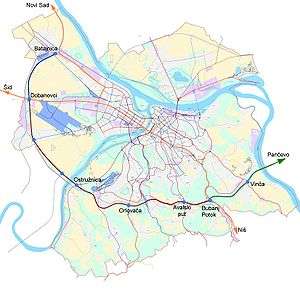Belgrade bypass

The Belgrade city road bypass[1] (Serbian: Обилазница око Београда / Obilaznica oko Beograda) or Belgrade bypass, is a bypass road currently under construction around the city of Belgrade, the capital of Serbia.
The project is financed from the National Investment Plan, the European Bank for Reconstruction and Development, and the European Investment Bank.[2] The total project is estimated at €543 million.[3]
The bypass was planned by the Belgrade's general urban planning, and its parts have been sporadically built for 17 years. However, the works intensified around the end of 2005.[3] Its construction is expected to help alleviate Belgrade's traffic congestion, and remove all transit traffic from the city center, unloading the critical Gazela and Pančevo Bridges. The total length of the bypass will be 69 kilometres.
On January 21, 2012, the Minister of Infrastructure of Serbia Milutin Mrkonjić has said that the Section B of the bypass will be opened for traffic in May 2012, 6 months before scheduled completion.[4] Mrkonjić repeated that promise on February 26, 2012.[5]
Sections
The bypass will consist of three principal sections:
- Section A: Batajnica–Dobanovci, connecting the Belgrade-Novi Sad highway (E75) on the north and Šid–Belgrade highway on the west (E70), 9.7 km long.
- Section B: Dobanovci–Bubanj Potok, connecting E70 with the southbound Belgrade-Niš highway (E75), 37.3 km long - partly finished (from Dobanovci to Orlovača)
- Section C: Bubanj Potok–Vinča–Starčevo (near Pančevo), 22 km long, crossing the Danube across a new bridge.[6]
Part of Section B from Dobanovci to Orlovača was finished and opened for traffic in October 2008.[7] All heavy trucks were banned on Gazela bridge in March 2010, effectively redirecting all truck transit over the Section B.[8]
Section A was opened for traffic in May 2012, along with the Orlovača–Straževica part of the Section B.[9] Batajnica interchange, the origin of section A, is still incomplete, with only one side of the viaduct in operation. Of the section B, the part between Straževica tunnel and Bubanj potok is still under construction, operating as single carriageway.
Section B, spanning the hilly terrain, will include 4 tunnels and 40 viaducts when completed, nine of them over 400 m long. In the final stage, it will also require enhancement of the existing Ostružnica bridge to accommodate the planned dual carriageway.[6]
Section C is technically the most complex, as its construction involves building a 1,190 m long bridge over the Danube, and additional 11 viaducts and 2 tunnels. Its exact route is not decided yet, and the completion is scheduled by 2017.[6]
References
- ↑ "Feasibility Study for Belgrade City Road By-Pass" (PDF). EBRD. 2008-08-16.
- ↑ "International financing and resettlement aspects of the Belgrade bypass project". CEE Bankwatch Network. 2007-07-10.
- 1 2 "Kao Skadar na Bojani". Bgd Novine. 2007-04-10.
- ↑ "Archived copy". Archived from the original on 2012-04-19. Retrieved 2012-01-21.
- ↑ http://www.mondo.rs/s235394/Info/Ekonomija/Obilaznica_oko_Beograda_gotova_u_maju.html
- 1 2 3 "Proposed plan for the Belgrade bypass project". CEE Bankwatch Network. 2007-07-10.
- ↑ "Drumski koridor 10 kroz Srbiju". glassrbije.org.
- ↑ "Zabrana za vozila teža od 3,5 tona" (in Serbian). B92/Beta. 2010-03-29.
- ↑ "Krenuo saobraćaj obilaznicom oko Beograda". Blic. 2012-05-03.
External links
- Beobuild.rs – news, discussions and photos of the bypass